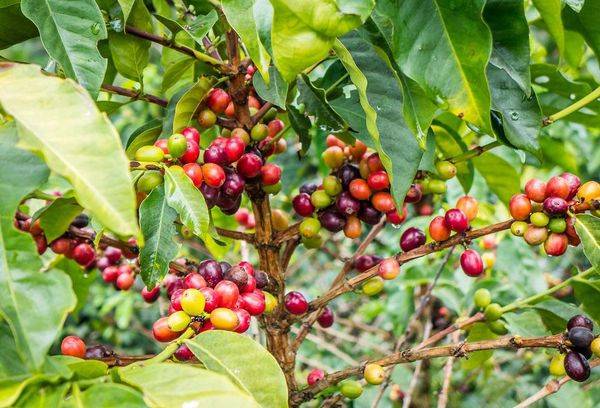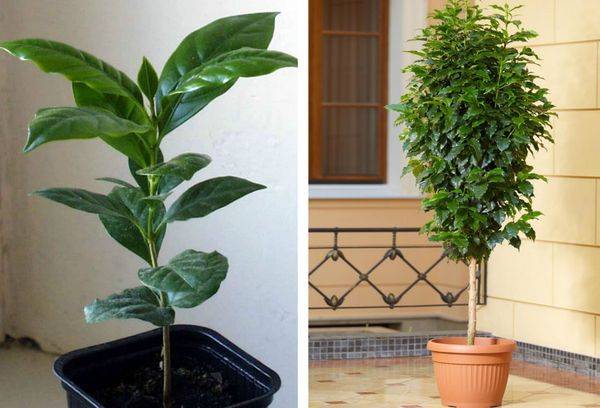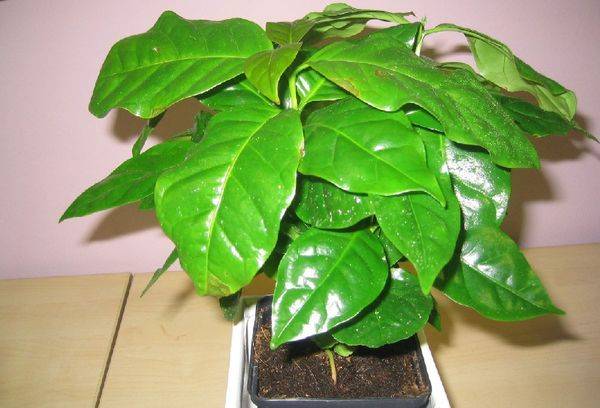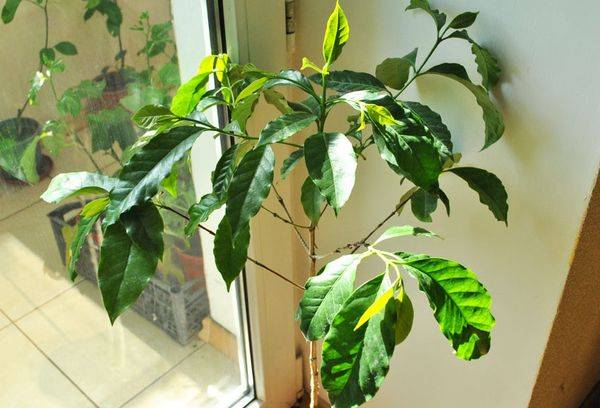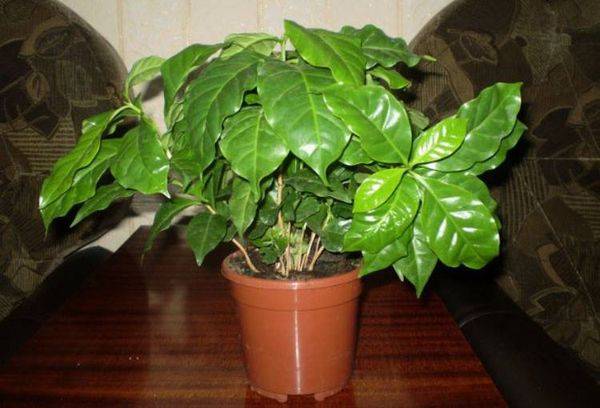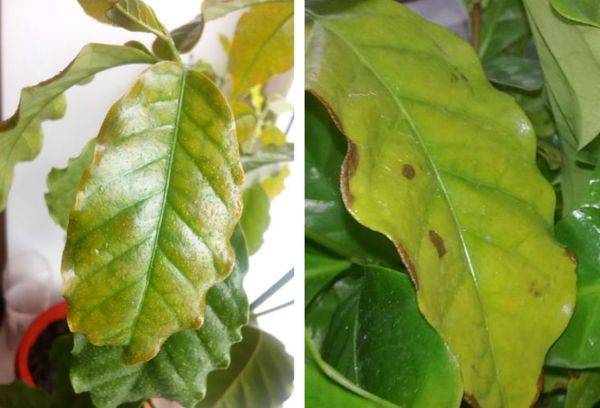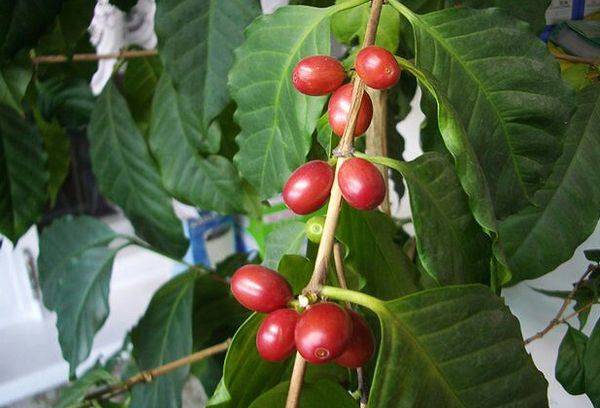Arabica Coffee Care at Home
Content:
An interesting idea for lovers of unusual flora: to grow an African tree at home - Arabica coffee. Caring for this tenant must be competent and constant. Although coffee adapts well to room conditions, it should nevertheless be provided with maximum comfort. After all, the main purpose of growing is nothing more than coffee beans: you can treat yourself to a coffee drink grown independently.
Description
Arabica coffee (Coffee tree Arabian, Coffea arabica) - a resident of tropical Africa, which is an evergreen shrub or tree. Despite its tropical origin, coffee tree is grown around the world, except in cold latitudes. In home flower growing, coffee is still rare, but this does not mean that an attempt to grow a strong and healthy plant is doomed to failure.
The coffee tree has long and inflexible branches forming a lush crown, which is valued for its decorative effect. The leaves of coffee are dark green, glossy, rounded, elongated, located opposite on the branches. The root system of the tree is small - this is another property that allows you to grow coffee in a pot. At home, Arabica coffee grows to 1 meter.
The coffee tree is the owner of self-pollinating flowers similar in shape to an asterisk. They are white in color, collected in small inflorescences (5 pieces each). The tree blooms from 4 years of life. Flowers are formed in spring. Six months after flowering, the fruits ripen - coffee beans. In the process of ripening, they acquire a deep dark red color. Each fruit contains 2 grains. Among coffee, it is Arabica that is most suitable for home growing in order to obtain coffee beans: the tree adapts well to home conditions.
There are several types of arabica:
- Typica - The original coffee from Ethiopia;
- Bourbon - Tipika mutation, productivity is 20-30% higher, but small in comparison with other species;
- Mundo Novo - a hybrid of Tipika and Bourbon, discovered in Brazil, is characterized by high productivity and resistance to disease;
- Maragogype - Tipika mutation found near the city of Maragogype in Brazil; features: low productivity, but gives the largest seeds;
- Blue mountain: a variety with unique flavors that grows in the Blue Mountains of Jamaica.
Tree care
Those who are satisfied with coffee arabica as an ornamental plant can not worry about the subtleties of caring for the plant. And for the green resident of the apartment to give fruits, he needs special care:
- Firstly, there should be enough light. At home, the coffee tree must be provided with maximum lighting so that it does not slow down the development. In the event of light deficiency, fruit ripening may be delayed. The trees set on the south side of the house feel comfortable, however, direct sunlight should not be allowed. This is the most common mistake of gardeners: after all, under natural conditions, coffee grows in a slight shade.
- In cold and cloudy weather, when there is not enough sunlight, coffee needs artificial lighting with a lamp.
- An important point: coffee loves when for a long time the lighting mode does not change. This means that the container with the coffee tree does not need to be constantly turned if you decide to wait for the harvest. And to create a uniform and lush crown, the pot is allowed to periodically rearrange.
- The coffee tree loves warmth. The optimum temperature for full growth and fruiting is + 25⁰ C.In winter, the temperature should not fall below +15.
- Water is required in large quantities, especially in the hot season. For irrigation, settled water (room temperature) is used (1-2 days). Each subsequent watering is carried out after the topsoil has dried. In winter, watering is reduced.
- Leaves also need attention, periodically spraying them with water. This procedure is carried out only when there are already or no buds on the tree. Although coffee is a moisture-loving plant, air humidity should not be too high.
- The plant is fed no more than once every 1.5 months. In spring, the tree needs nitrogen and phosphorus. For feeding, choose bone meal, horn chips or ready-made liquid mineral fertilizers.
- Pruning is not well tolerated by the plant, so remove dried branches only as necessary. To create a beautiful crown, it is sometimes allowed to pinch the side shoots.
Tip
To maintain soil acidity, add a few drops of vinegar to the water when watering. Granules of citric acid are suitable for this purpose.
Reproduction and transplantation
Arabica coffee is propagated by seeds. In order to germinate the grain, the berry needs to be peeled and washed. Then the seed is placed in a weak solution of potassium permanganate for half an hour. After the disinfection procedure, the seeds are immediately planted in the ground (to the surface) with the flat side up. Shoots appear after 6 weeks.
Coffee tree propagates well by cuttings. For this, the twig is cut at an angle, soaked in a disinfectant solution, then deepened into the soil by 3 cm. With the advent of new leaves, a transplant is made into a suitable container. It is noteworthy that the arabica grown by means of cuttings fructifies in 1.5 years.
Young seedlings are transplanted annually. A transplant of an adult plant (from 3 years) is carried out no more than once every 2-3 years. Since the coffee tree grows to 1 m, care should be taken in advance about the capacity and location in the house so as not to disturb the plant again. Transplant the tree into a large container so that the root system develops inland. So coffee will receive maximum nutrients from the soil.
purityis.decorexpro.com/en/ magazine draws attention to the fact that the soil for seeds and cuttings is different from the soil mixture for transplanting an adult plant:
- For seeds, you need a soil mixture of leaf soil and river sand. Such a soil easily absorbs moisture necessary for active growth. Before planting the seed in the substrate, it must be disinfected: put a container with soil in a water bath and hold for 5 minutes.
- When the first leaves appear in a seedling, it needs a transplant into the ground for an adult plant: peat, leaf soil, sand, humus, moss and charcoal are taken in equal proportions. If it is not possible to prepare such a soil yourself, you can always purchase a ready-made soil mixture in a specialized store.
Growing problems, diseases and pests
Homemade coffee tree sometimes presents unpleasant surprises. Florists are faced with problems of growth, leaf color, staining. Causes and effects of coffee growing problems:
- Leaves lose their saturated color and luster. The likely cause is the low acidity of the soil.
- If the leaves turn yellow and dry, this may be a sign of a lack of moisture or fresh air.
- If the leaves rot, check that the humidity in the room where the coffee grows is normal.
- The fruits do not appear - perhaps the pot with the tree was often rearranged.
- If the plant was attacked by pests, then the conditions of irrigation, lighting and soil acidity were violated.
What pests most often affect homemade coffee tree:
- spider mite,
- aphid,
- scale shield
- mealybug.
Anti-scabbing helps the treatment of affected areas with alcohol. If the plant is damaged by insects, remove the affected parts and treat the bush with a solution of malathion (10 drops per 500 g of water).In the case of a fungal disease, treatment with copper sulfate or a special antifungal agent helps. In any case, compliance with the conditions of detention is much more convenient than the treatment of the disease, so provide your exotic tree with enough light, heat, air and water.
Interesting Facts
Why is it worth choosing Arabica coffee?
Here are some interesting facts about this plant:
- From one home tree, up to 500 g of green coffee beans are collected annually.
- Historical note: coffee tree has existed for about a thousand years. This plant became decorative about 300-400 years ago.
- The flowering period takes only 2-3 days, and the fruit ripens for six months.
- The caffeine content in self-grown beans is several times higher than in coffee from the store.
- Arabica accounts for about 70% of the world's coffee plantings.
Although coffee is not yet so popular in home gardening, trying to grow it is definitely a good idea. For decorative purposes, the plant harmoniously fits into any interior. And self-grown coffee beans will be an excellent occasion to gather relatives for a cup of aromatic drink.

